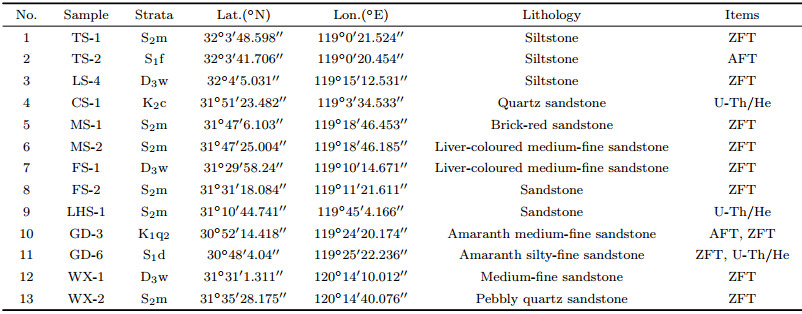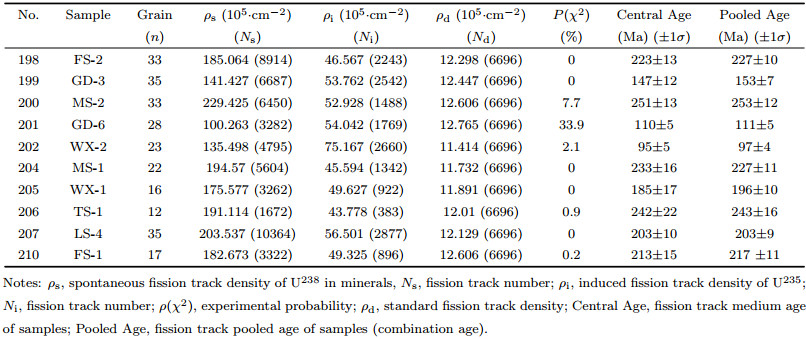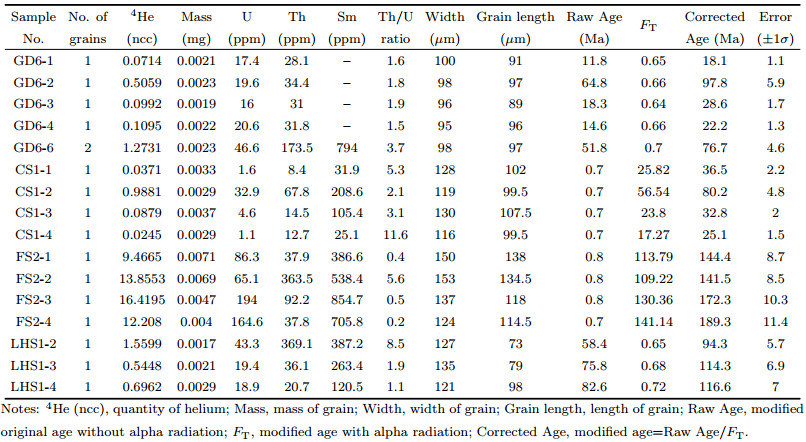2 Petroleum Exploration and Production Research Institute of East China Branch, SINOPEC, Nanjing 210011, China
The Lower Yangtze area suffered intensive Indosinian-Yanshanian tectonic transformation, which resulted in intensive deformation, heterotaxy and sequence change in marine strata, and the early formed oil and gas reservoir suffered severe destruction (Zhao et al., 2002; Ding et al., 2009). On the one hand the success of marine petroleum exploration relies on the Lower Paleozoic which has favorable geologic conditions of large gas reservoir (Yu et al., 2001). The Lower Paleozoic developed high quality hydrocarbon source rock, experienced high degree of thermal evolution, and has favorable reservoir conditions and large thickness of Silurian shale cap rock. On the other hand, it relies on ‘secondary hydrocarbon generation’ (‘late hydrocarbon generation’) which was resulted from superimposition of new basins in a relatively weak tectonic period from the Late Cretaceous to Tertiary (Chen et al., 2001). The paleotemperature of basin is a necessary parameter in studying of hydrocarbon generation of source rocks (Qiu et al., 2000), which was controlled by both burial depth and geothermal gradient. The thermal events generally made paleo-heat flow significantly elevated, and then the paleotemperature gradient and formation temperature increased. The potential of secondary hydrocarbon generation of the Paleozoic marine source rocks is mainly related with temperature increase in late burial-depth and early thermal evolution of organic matter. Therefore, determination of time and intensity of thermal events is a key to evaluate the ‘secondary hydrocarbon generation’ and potential of marine petroleum exploration in Lower Yangtze area.
There is not much previous work about tectonothermal evolution of sedimentary basin in Lower Yangtze area. The thermal history in Jurong-Hai0an area of Lower Yangtze was reconstructed by Yuan Yusong through geologic thermometer evolution method (Yuan et al., 2005; Yuan et al., 2006), but the controlling of time nodes of thermal history was mainly based on unconformity and tectonic activities. The impact of magmatic activity on clastic zircon fission track (ZFT) age was discussed by Wang et al. (2011), and the relation between apatite fission track (AFT) age and tectonic events was also analyzed (Wang et al., 2014). The tectonothermal history since the Late Cretaceous in Lower Yangtze area was analyzed by Zhang et al. based on AFT data of PukouFm sandstone, and it was believed that the formation had experienced uplifting and structural inversion since the Oligocene (Zhang et al., 2009). Fortunately, there is much more research about present-day geothermal field and lithosphere thermal characteristics (Wang et al., 1995; Li et al., 1996; Wang et al., 2013), which provides basic parameters for thermal history reconstruction. In this paper, the time of tectonothermal events in the central Lower Yangtze area was restricted by structural and sedimentary records, ZFT age, AFT age and apatite U-Th/He age data and the intensity of thermal events were estimated by paleotemperature index (Ro) inversion. Moreover, the impact of the tectonothermal events on hydrocarbon generation of the marine source rocks was discussed.
2 GEOLOGICAL BACKGROUNDThe Lower Yangtze area developed Sinian-Middle Triassic marine basins, Late Triassic-Middle Jurassic foreland basins, Late Jurassic-Early Cretaceous volcanic basins and Late Cretaceous-Paleogene continental extension basins (Zhu et al., 2000). There exist at least 13 tectonic movements with evident formation sedimentary records, including Tongwan, Guangxi, Suwan, Jinzi, Nanxiang, Ningzhen, Yanshanian-Ⅲ, Huangqiao, Yizheng, Hai’an, Wubao, Zhenwu, and Sanduo movement. The marine series experienced three types of transformation activities with different nature, i.e. T3-J2 fold-thrust, J3-K1 strike-slip with magmatism, and K2-E extensional faulted-depression and inverted structure activities (Zhu et al., 2000). The Indosinian-Yanshanian activities were marked by compressional basins with intensive extrusion modification. The structural styles of marine Mesozoic and Paleozoic sequences in Lower Yangtze area is characterized by large scale of thrusting and folding. The weaker foreland transformation is closed to frontal zone, namely the areas along the Yangtze River (Zhu et al., 1999). The Suzhou-Wuxi-Changzhou area is an area with petroleum exploration potential in marine sequences, where the transformation is relatively weaker (Li et al., 2011). The central Lower Yangtze foldingfaulted belt, with Mount Maoshan as a border, presents structural transformation difference from east to west. The eastern area has a shallower detachment layer and a weaker negative inversion structural transformation and magmatism, which are more favorable conditions of hydrocarbon preservation, and it is a hopeful area for breakthrough of marine petroleum exploration (Zhang et al., 2013). Therefore, the study of this paper is focused on Jurong-Changzhou-Taixing area.
3 TIME OF TECTONOTHERMAL EVENTS 3.1 Structural and Sedimentary RecordsThe thermal events of sedimentary basins were generally accompanied by tectonic events. The TangshanLunshan geologic profile shows that formations from Cambrian to Permian wholly thrusted over Middle Triassic Huangmaqing Fm, and the Upper Cretaceous Pukou Fm unconformably overlaid the nappe from Cambrian to Permian (Du, 1997). It is clear that the nappe structure formed between the end of the Middle Triassic (Indosinian movement) and the Late Cretaceous. Moreover, the Maoshan geologic profile shows that SilurianTriassic and Jurassic Fm thrusted over the Lower Cretaceous Gecun Fm (K1g), and the Upper Cretaceous Pukou Fm (K2p) overlaid the nappe composed of Silurian-Triassic and Jurassic Fm (Huang et al., 2010), which shows that thrusting tectonic event occurred between the Early Cretaceous and Late Cretaceous in Maoshan area. The seismogeology interpretation profile of Jurong area across well N3 shows that the Mesozoic-Paleozoic overthrust was covered by the Lower Cretaceous Gecun Fm, which was unconformable with the Upper Cretaceous Gecun Fm (Fig. 1). It shows that the tectonic event occurred before the deposition of the Early Cretaceous Gecun Fm.
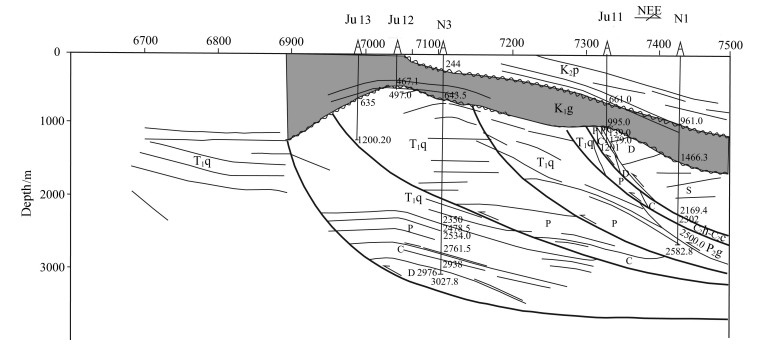
|
Fig. 1 Seismogeology interpretation profile of Jurong in Lower Yangtze area across well N3 (Hu et al., 1985) |
In conclusion, the structural and sedimentary records show that the tectonic events in Lower Yangtze area occurred at Indosinian Period (T3-J2) and Yanshanian Period (K1g-K2). The tectonic activities in the two periods forming the nappe structures show some differences in different areas.
3.2 Chronology DataMinerals have different fission track annealing temperatures. For example, ZFT full annealing temperature is about 205±18 ℃ (Bernet, 2009), and AFT full annealing temperature is about 100±20 ℃ (Laslett et al., 1987), and apatite U-Th/He closure temperature is about 75±7 ℃ (Wolf et al., 1996). The above temperature values can be an integrated thermometric scale in petroleum exploration depth of sedimentary basin. 13 pieces of low temperature thermochronology samples were obtained from Tangshan, Maoshan, Lunshan, Fangshan, Guangde, and Wuxi areas in Lower Yangtze. Among them, the CS-1 and GD-3 were from Cretaceous formation, and the other samples were from the Silurian-Devonian. The detailed information of the samples is shown in Table 1, and sampling location is shown in Fig. 2. The AFT, ZFT, and apatite U-Th/He analyses were conducted based on selection of mineral grain.
|
|
Table 1 Sample information for low-temperature thermochronolgy in Lower Yangtze area |
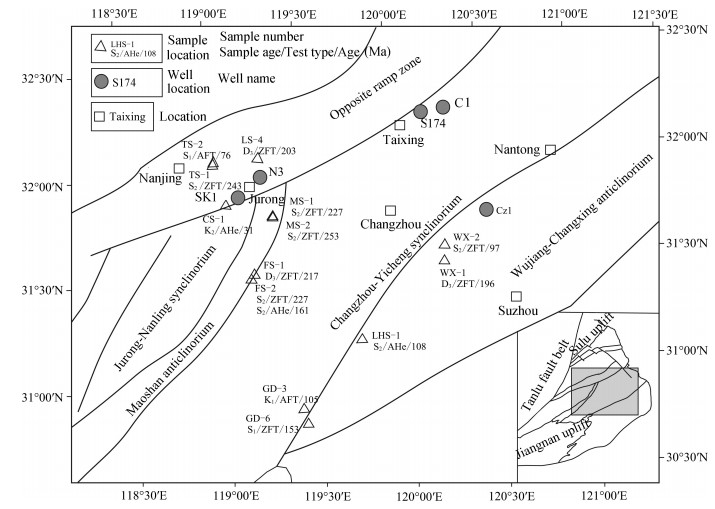
|
Fig. 2 Sample locations for low-temperature thermochronolgy in the central part of the Lower Yangtze area ZFT, Zircon fission track; AFT, Apatite fission track; AHe, Apatite U-Th/He. |
Table 2 is ZFT analysis results, which shows the following characteristics. The first is that the ZFT age of Silurian-Devonian samples is far younger than their stratigraphic age, and the pooled age is between 203~253 Ma, averaging 228±11 Ma. The ZFT age of Cretaceous samples is older than their stratigraphic age. For example, ZFT age of the sample GD-3 is 153 Ma, which is much older than stratigraphic age ( < 137 Ma). The second is that the age of most samples did not pass χ2 test; GD-6 from Guangde area and MS-2 from Mountain Maoshan has P (χ2) > 5%, and the other samples have P (χ2) < 5%. The third is that the ZFT age of the samples from Maoshan, Tangshan, and Fangshan is older than that of samples from Guangde and Wuxi areas. The ZFT ages show that the Silurian-Devonian samples had experienced full annealing, but the Cretaceous samples did not reached AFT full annealing temperature. ZFT age of most samples is not cooling age, but mixed age, reflecting multi-provenance, multi-components and/or several tectonothermal events. The tectonothermal events in Maoshan, Tangshan, and Fangshan occurred earlier than that in Wuxi and Guangde area. In other words, the time of uplifting and cooling in Guangde-Wuxi belt is later than that in Tangshan and Maoshan area, and the former is T3-J2 and the latter is K1-K2.
|
|
Table 2 Zircon fission track age data in the central part of the Lower Yangtze area |
Only limited apatite minerals were selected from the samples and only two pieces of sample are suitable for AFT analysis. The AFT analysis data are shown in Table 3. The TS-2 from Tangshan was sampled from Silurian formation, and both AFT central age and pooled age are about 76 Ma, and single-grain age is between 49~115 Ma, which is much older than their formation age. The age of grain has passed χ2 test, and it represents uplifting and cooling age. However, AFT length has a more complex distribution, with a non-typical doublepeak characterized by a positive skewness with more long tracks (Fig. 3). The GD-3 from Guangde area was sampled from the Lower Cretaceous Qifangcun Fm. Its AFT central age and pooled age are 108 Ma and 105 Ma, respectively, which are close to the formation age. The ages of grains did not pass χ2 test, so it does not represent uplifting and cooling age. Moreover, AFT length has a more complex distribution, with a non-typical double-peak, and a little extremely short track, showing the age is mixture of part annealing and mother-rockbearing apatite fission track age (Fig. 4).
|
|
Table 3 Apatite fission track age data in the central part of the Lower Yangtze area |
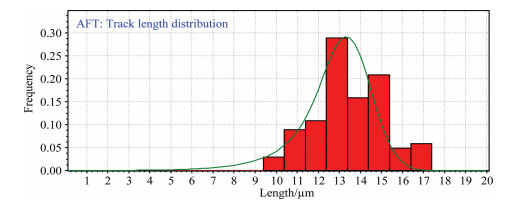
|
Fig. 3 AFT length distribution of Silurian samples from Lower Yangtze Nanjing Tangshan area |

|
Fig. 4 AFT length distribution of Lower Cretaceous samples from Lower Yangtze Guangde area |
The test of apatite U-Th/He age was conducted in University of London. Four sample’s apatite U-Th/He age data are listed in Table 4, which shows that apatite U-Th/He age of Silurian samples (GD6, FS2 and LHS1) and Cretaceous sample (CS1) are smaller than their formation ages. GD6 Silurian sample and CS1 Upper Cretaceous sample have a U-Th/He age between 18~98 Ma, which is smaller than that of the other two samples. Their apatite U-Th/He single-grain age could be divided into two groups, the younger one of GD6 is between 18~29 Ma, and the older one is between 76~97 Ma. Similarly, the younger age group of sample CS1 is between 25~36 Ma, and the older one is about 80 Ma. The factors influencing the difference of U-Th/He single-grain age include detritus source, grain size, apatite components, etc. The difference of AFT U-Th/He single-grain age of sample GD6 from the Silurian is possibly related to grain size, and the grain with older age has a larger size. The average single-grain age is about 48.7 Ma, which roughly reflects that the onset time of Himalayan uplifting at the sampling location is in the Paleogene. The difference of U-Th/He single-grain age of CS1 sample is possibly related to the difference of apatite components resulted from multi-detritus source. One grain has an age of 80.2 Ma, and other 3 grains have an average age of 31.5 Ma, which is possibly because of the Oligocene tectonic movement (Sanduo movement). FS2 sample from Fangshan area and LHS1 sample from Laohushan area have a much old apatite U-Th/He age, with a smaller difference of single-grain age and an average value of 161.9±9.7 Ma and 108.4±6.5 Ma respectively. It shows that the Yanshanian-period uplifting at the sampling location is during the Late Jurassic-Early Cretaceous (J3-K1).
|
|
Table 4 Apatite U-Th/He age data from the central part of the Lower Yangtze area |
A series of volcanic basins in Lower Yangtze area had formed in same period. The zircon U-Pb ages of Lingxiang Fm volcanic rocks in Jinniu Basin is 130.9±1.5 Ma, and the ages of Lower and Upper members of Zhongfencun Fm volcanic rocks in Fanchang Basin is 131.2±1.1 Ma and 129.1±1.3 Ma respectively. The Niangniangshan Fm volcanic rocks is 130.0±1.1 Ma in Nanjing-Wuhu basin, and the zircon 206Pb/204Pb weighted average concordant age of Pengjiakou Fm and Jiangzhen Fm volcanic rocks in Huaining Basin is 130.0±1.7 Ma (MSWD=0.73) and 130.5±1.7 Ma (MSWD=0.78) respectively (Yan et al., 2013). The eruption period of volcanic in these basins is concentrated between 127~132 Ma, averaging 130±2.5 Ma (Tang, 2011), which is an Early Cretaceous product, with much shorter eruption duration. The isotopic age of Lower Cretaceous Longwangshan Fm, Dawangshan Fm, Gushan Fm and Niangniangshan Fm is 135±3.5 Ma, 132.8±5.1 Ma, 129.5±1.9 Ma, 126.6±2.1 Ma respectively, with a concentrated eruption period (Zhou et al., 2011).
Magmatic thermal events were normally accompanied by tectonic events. The magmation is widespread in Lower Yangtze area, including volcanic activities in Indosinian, Yanshanian and Himalayan periods, and among them, the Yanshanian magmation is the most intensive one (Ma et al., 2011). The change of formation temperature in areas with weaker magmation is usually related with tectonic movements (e.g. uplifting denudation) (Qin et al., 2010). On the contrary, the volcanic thermal event is a main controlling factor which caused change of formation temperature in areas with intensive magmatism.
In conclusion, the tectonic and sedimentary records, ZFT ages, AFT ages and their length distribution, and apatite U-Th/He ages and volcanic isotopic age data show the existence of tectonothermal events such as Indonesian tectonic event (T3-J2), Yanshanian tectonic event (K1g-K2), Yanshanian magmation thermal event (K1) and Himalayan tectonic event (Paleogene) which caused significant change of sedimentary formation temperature.
4 INTENSITY OF THERMAL EVENTSThe intensity of thermal events of sedimentary basin can generally be estimated by the elevation of paleoheat flow which is obtained through thermal history inversion using paleothermometer in basin scale. The tool we used for thermal history inversion is the software Thermodel for Windows developed by Professor Shengbiao Hu and introduced in detail by Zhang et al. (2005). The paleo-heat flow inversion method (Hu et al., 1998) was employed in the thermal history inversion and carried out in well Shengke-1 (SK1), N3, Su-174 (S174) and Chang-1 (C1) with systematic geothermometer Ro data. These representative wells are scattered in the studying area (see Fig. 2).
The present-day surface temperature for thermal history inversion refers to the temperature of the constant temperature zone in the Lower Yangtze area, which is about 14.6 ℃. Based on the present average surface heatflow of 68 mW·m−2 in Subei Basin and 60 mW·m−2 in Southern Jiangsu respectively (Wang et al., 1995; Yuan et al., 2005; Yuan et al., 2006), the surface heat-flow for simulation is restricted between 60~70 mW·m−2. The early thermal history information is usually covered by maximum paleogeotemperature, so only the thermal history after maximum paleogeotemperature could be reconstructed through geothermometer. Therefore, the Paleozoic thermal history usually could not be directly obtained in the process of geothermometer thermal history inversion in old sedimentary basins. In this study, Paleozoic and previous heat flow value is obtained through geophysical inversion in lithosphere scale. The geophysical inversion based on uniform extension model (McKenzie, 1978), considering the influence of rock heat generation rate, shows that the heat flow at the end of Silurian in Lower Yangtze area was between 1.1~1.2 HFU (Li et al., 1996), namely around 50 mW·m−2. Combined with this heat flow value, the Paleozoic heat flows at every geological period were constrained by thermal history inversion when the calculated Ro could be compatible with the measured Ro data.
The thermal history inversion (Fig. 5) shows that well SK1 in Jurong area had experienced PaleozoicMiddle Triassic low heat flow stage, late Indosinian-early and middle Yanshanian slightly increased heat flow, late Yanshanian high heat flow and Himalayan cooling. The maximum paleo-heat flow occurred at about 130 Ma, namely the early period of the Early Cretaceous. The maximum paleo-heat flow in bottom hole is about 88 mW·m−2, and the maximum surface paleo-heat flow is about 94 mW·m−2 in well SK1. Jurong area entered a cooling stage since the deposition of the Upper Cretaceous Pukou Fm, and it continued until 65 Ma B.P. when it became stable. The heat flow inversion result of well N3 was the same as well SK1, which showed that the heat flow increased gradually from Paleozoic to Mesozoic, and at about 130 Ma reached maximum bottom hole paleo-heat flow of 89 mW·m−2 and maximum surface paleo-heat flow of 93 mW·m−2. Well S174 in Taixing area had experienced Caledon-Hercynian low heat flow stage, Indosinian-early and middle Yanshanian largely increased heat flow, maximum bottom hole paleo-heat flow of 73 mW·m−2 and maximum surface paleo-heat flow of 77 mW·m−2 in about 130 Ma, characterized by late Yanshanian high heat flow and Himalayan cooling. Well Chang-1 (C1) in Taixing area had experienced an increased heat flow from Paleozoic to Mesozoic, a maximum bottom hole paleo-heat flow of 73 mW·m−2, and maximum surface paleo-heat flow of 78 mW·m−2 at about 130 Ma. It implies that the basin entered a cooling stage since 130 Ma and became stable since 100 Ma. The thermal history track of well C1 is the same as well S174.

|
Fig. 5 Terrestrial heat flow history of the central part of Lower Yangtze area |
The thermal history of the central part of Lower Yangtze area is characterized by low heat flow in the early Paleozoic, slightly elevated heat flow in the Late Paleozoic and high heat flow during Indosinian-Yanshanian period and moderate heat flow from the Late Cretaceous to Present-day. In the early Paleozoic the surface paleo-heat flow was between 45~50 mW·m−2. The paleo-heat flows lightly increased during the Late Paleozoic and reached its maximum value of 77~94 mW·m−2 at about 130Ma and decreased to 60~70 mW·m−2 of present-day surface heat flow, reflecting an intensive thermal event followed by a cooling event from Mesozoic to Cenozoic. In Taixing area heat flow slightly increased from the Late Cretaceous to Paleogene, while in Jurong area heat flow had become stable since the Late Cretaceous. The early low heat flow period corresponded to stable Paleozoic-middle Triassic marine basin evolution stage in the Lower Yangtze area, and the IndosinianYanshanian high heat flow was caused by intensive extrusion and tectonic thermal effect, and Himalayan cooling process indicated relatively weaker tension, thicker lithosphere and relatively cooler lithosphere in central part of Lower Yangtze area. The Lower Yangtze thermal history variation corresponds to four evolution stages of North China Craton. The geothermy and magmation research and numerical simulation of He (2014) showed that the evolution of North China Craton included slightly thinned lithosphere caused by Jurassic Pacific Plate subduction, Early Cretaceous largely thinned and broken lithosphere, Late Cretaceous-Paleogene multi-period tension, and cooling stage since Neogene (He, 2014; He, 2015), and it is possible that the eastern Chinese Mainland had uniform deep dynamics mechanism since Mesozoic.
Moreover, the intensity of the thermal events in the Early Cretaceous in Lower Yangtze area seems to present a trend of gradual decreasing from west to east. Jurong area has a peak paleo-heat flow larger than that of Taixing area. The distribution characteristics of paleo-heat flow in Lower Yangtze obtained from geothermometer inversion could be supported by coalification gradient Ro profile, which shows difference in WuweiJurong-Huangqiao areas. Wuwei area had an extremely high coalification gradient, which was 2.9/km in well N-Can4 (NC4), and Jurong area had a value of 0.7/km in well SK1, but Huangqiao area only had a value of 0.4/km, which was much lower than the former two (Fig. 6).
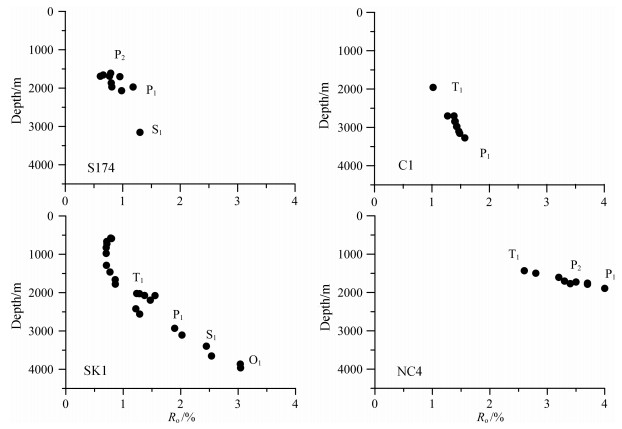
|
Fig. 6 Geothermometer Ro profiles of representative wellsin Lower Yangtze area |
Lower Yangtze marine formation had developed Upper Sinian, Lower Cambrian, Ordovician, Lower Silurian, Permian, and Lower Triassic source rocks, including argillaceous rock, carbonate rock, and coal petrography. The Lower Cambrian, Lower Silurian, and Permian formation have higher abundance of organic matter, with higher hydrocarbon generation potential, and they are the main marine source rocks (Lin et al., 2007; Zeng, 2010). The discussion is limited to the hydrocarbon generation of the Lower Cambrian source rock, because of synchronism of influence of the Mesozoic thermal events on the other marine source rocks.
Marine formations in south China has a multi-element hydrocarbon generation characteristic, including kerogen generated hydrocarbon and the unexpelled liquid hydrocarbon generated gas and the gas generated from oil cracking of liquid hydrocarbon which has been expelled from source rocks. The study takes the Lower Cambrian Mufushan Fm source rock as an example, and it mainly takes into account hydrocarbon generation of kerogen and gas generation of unexpelled liquid hydrocarbon through cracking. Ro corresponding to massive oil cracking into gas is about 1.6%, and when Ro reached 3.5% oil cracking into gas stops (Zhao et al., 2006). Comprehensively considering the hydrocarbon generation of kerogen and gas generation of oil cracking, organic matter thermal evolution degree index Ro=0.5% is defined as the begining of hydrocarbon generation, and Ro=0.5%~1.3% is defined as oil-generation period, and Ro=0.5%~0.7% is early period of oil generation, and Ro=0.7%~1.3% is peak of oil generation, and Ro=1.3%~3.5% is gas generation period, and Ro=1.3%~2.6% is defined as main gas generation period of kerogen, and Ro=1.6%~3.5% is gas generation period of oil cracking (the oil refers to the unexpelled disperse hydrocarbon in source rock), and Ro >3.5% is defined as the end of hydrocarbon generation.
Based on burial history and heat-flow history reconstructions, the forward modeling of hydrocarbon generation of source rock is conducted by EASY%Ro model (Sweeney et al., 1990). The forward modeling result of Well Shengke-1 in Jurong area is shown in Fig. 7, and the hydrocarbon generation history of the Lower Cambrian source rock in some representative wells and a virtual well from seismic data are shown in Fig. 8.
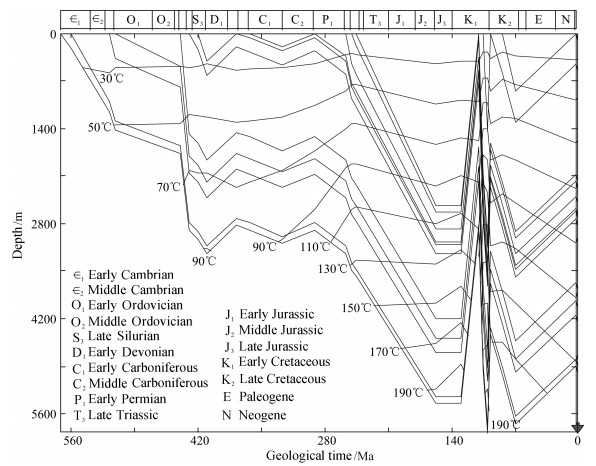
|
Fig. 7 History of organic matter maturity of well SK1 in Jurong area |
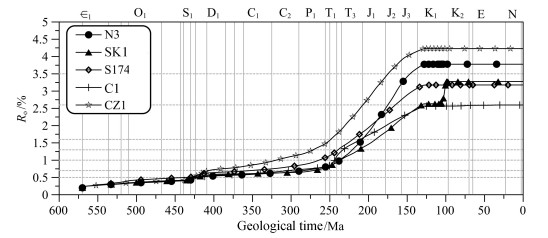
|
Fig. 8 Maturity history of Cambrian source rocks in central Lower Yangtze area |
The results show that the oil generation peak of Cambrian source rock is in the Early and Middle Triassic (Ro=0.7%~1.3%), and main gas generation period is the Late Triassic-Late Jurassic (Ro=1.3%~2.6%), and oil cracking began after Jurassic (Ro=1.6%~3.5%) in Taixing and Jurong areas. However, owing to high temperature resulted from tremendous thick Silurian formation in the area of the Virtual well CZ1 from SP3500 of the CZ-2015nw4200 seismic profile in Changzhou area, the Cambrian source rock experienced an earlier hydrocarbon generation than that in Taixing and Jurong areas. Its peak of oil generation is in the Late Paleozoic, and the main gas generation period is in late Permian-late Triassic, and the oil cracking period is during the Middle Triassic-Middle Jurassic (Ro=1.6%~3.5%) in the Virtual well CZ1.
It is clear that organic matter maturity history and hydrocarbon generation history of the Lower Cambrian source rock show the following characteristics: The first is that the beginning, the peak, and the end of hydrocarbon generation in Jurong and Taixing area are basically the same. Except for the well SK1 which shows a certain extent of elevated maturation of source rock because of the elevated temperature resulted from the Early Cretaceous nappe, the stop time of hydrocarbon generation of the Cambrian source rock is generally at the end of the Late Jurassic. The second is that the Cambrian source rock in Changzhou area has an earlier hydrocarbon generation time because of the overlying thick Lower Paleozoic formation. The third is that large-scale secondary hydrocarbon generation probably does not exist in central Lower Yangtze area because the organic matter of source rock in Jurong, Taixing and Changzhou area reached their maximum paleotemperature in Yanshanian period owing to dual function of T3-J1−2 foreland basin deposition and Yanshanian magmation tectonothermal events. Although the Lower Paleozoic marine source rocks experienced deeper burial depth in K2-E than that in previous stage, the organic matter maturity did not further increase as the temperature did not increase in K2-E in most parts of the central Lower Yangtze area.
6 CONCLUSIONS(1) Lower Yangtze Mesozoic tectonothermal events began in Indosinian period (T3-J2), and reached its peak in Yanshanian period (late Jurassic-early Cretaceous). The maximum paleo-heat flow of sedimentary basin occurred at about 130~110 Ma.
(2) The intensity of the thermal events shows a decreasing trend from west to east in the central Lower Yangtze area. The maximum surface paleo-heat flow in Jurong area is about 94 mW·m−2, while it is about 78 mW·m−2 in Taixing area.
(3) The thermal maturity of marine source rock organic matter was seriously influenced by the thermal events. The Cambrian source rock in Jurong, Changzhou, and Taixing area where the Mesozoic tectonic transformation is relatively weaker and therefore more favorable to marine petroleum preservation, had finished hydrocarbon generation at the end of late Jurassic. Therefore, there was no large-scale secondary hydrocarbon generation since the Late Cretaceous in the central Lower Yangtze area.
ACKNOWLEDGMENTSThis paper was financially supported by the National Science & Technology Special Project (2016ZX05061-001) and the National Key Foundational Research and Development Project (2012CB214806).
| [] | Bernet M. 2009. A field-based estimate of the zircon fission-track closure temperature. Chemical Geology , 259 (3-4) : 181-189. DOI:10.1016/j.chemgeo.2008.10.043 |
| [] | Chen A D, Liu D Y, Liu Z M. 2001. Evidence and quantitative research of the sencondary hydrocarbon generation of marine source rocks in the Lower Yangtze area. Marine Petroleum Geology (in Chinese) , 6 (4) : 27-33. |
| [] | Deng H, Zhou J, Zhao Z, et al. 1999. Basin types and reformation of the Sinian-Middle Triassic marine successions in the Lower Yangtze area. Marine Petroleum Geology (in Chinese) , 4 (3) : 38-45. |
| [] | Ding D G, Wang D Y, Liu Y L. 2009. Transformation and deformation of the Paleozoic basins in lower Yangtze areas. Earth Science Frontiers (in Chinese) , 16 (4) : 61-73. |
| [] | Du G Y. 1997. Study of Tang-Lun nappe structure in Ningzhen mountain range. Yantai Teachers University Journal(Natural Science) (in Chinese) , 13 (2) : 58-63. |
| [] | He L J. 2014. Numerical modeling of convective erosion and peridotite-melt interaction in big mantle wedge:Implications for the destruction of the North China Craton. J. Geophys. Res. , 119 (4) : 3662-3677. DOI:10.1002/2013JB010657 |
| [] | He L J. 2015. Thermal regime of the North China Craton:Implications for craton destruction. Earth-Science Reviews , 140 : 14-26. DOI:10.1016/j.earscirev.2014.10.011 |
| [] | Hu S B, Zhang R Y, Zhou L C. 1998. Methods for thermal history reconstruction of oil-gas basin. Petroleum Explorationist(in Chinese) , 3 (4) : 52-54. |
| [] | Hu T S, Lu H, Yang Z Y. 1985. Geological report of well completion of the N3 (in Chinese). Shanghai:Sinopec East China Branch, 73. |
| [] | Huang R S, Cao J Z. 2010. Analysis and study on Maoshan nappe tectonic zone in Jiangsu. Journal of Geology (in Chinese) , 34 (1) : 6-9. |
| [] | Laslett G M, Green P F, Duddy I R, et al. 1987. Thermal annealing of fission tracks in apatite 2. A quantitative analysis. Chemical Geology:Isotope Geoscience Section , 65 (1) : 1-13. DOI:10.1016/0168-9622(87)90057-1 |
| [] | Li C, Wang L S, Shi Y S. 1996. Deep thermal state and lithospheric thickness in the Lower Yangtze area. Journal of Nanjing University (Natural Sciences) (in Chinese) , 32 (3) : 494-499. |
| [] | Li H B, Jian D, Wu L, et al. 2011. The Mesozoic-Cenozoic compressional deformation, extensional modification and their significance for hydrocarbon exploration in the Lower Yangtze region. Acta Petrologica Sinica (in Chinese) , 27 (3) : 770-778. |
| [] | Lin X Y, Liu J, Chen Z L, et al. 2007. Marine source rock distribution and hydrocarbon generation potential in middle and lower Yangtze region. Journal of Oil and Gas Technology (in Chinese) , 29 (3) : 15-19. |
| [] | Ma F, Xue H M. 2011. SHRIMP zircon U-Pb age of late Mesozoic volcanic rocks from the Chuzhou basin, eastern Anhui Province, and its geological significance. Acta Petrologica et Mineralogica (in Chinese) , 30 (5) : 924-934. |
| [] | McKenzie D. 1978. Some remarks on the development of sedimentary basins. Earth and Planetary Science Letters , 40 (1) : 25-32. DOI:10.1016/0012-821X(78)90071-7 |
| [] | Qin J Z, Wang J, Qiu N S, et al. 2010. New paleo-geothermometers for the inversion of dynamic thermal evolution history of marine sequences in South China. Oil & Gas Geology (in Chinese) , 31 (3) : 277-287. |
| [] | Qiu N S, Zha M, Wang X L. 2000. Simulation of geothermal evolution history in Junggar Basin. Xinjiang Petroleum Geology (in Chinese) , 21 (1) : 38-41. |
| [] | Sweeney J J, Burnham A K. 1990. Evaluation of a simple model of vitrinite reflectance based on chemical kinetics. AAPG Bulletin , 74 (10) : 1559-1570. |
| [] | Tang Y L. 2011. The chronology and stratigraphic comparison of Late Mesozoic volcanic rocks from the Lower Yangtze region (in Chinese)[Master thesis]. Hefei:Hefei Universityof Technology, 62. |
| [] | Wang D P, Xu C H, Jiao R H, et al. 2011. Thermotectonic evolution history of the Lower Yangtze area based on detrital zircon fission track analysis. Journal of China University of Mining & Technology (in Chinese) , 40 (2) : 227-234. |
| [] | Wang D P, Zhan X H, Wang J. 2014. Evidence of fission Track data for thermotectonic evolution history of the Lower Yangtze area. Offshore Oil (in Chinese) , 34 (3) : 55-60. |
| [] | Wang H Y, Liu S W, Lei X. 2013. Present geothermal regime of the Lower Yangtze area, South China. Journal of China Coal Society (in Chinese) , 38 (5) : 896-900. |
| [] | Wang L S, Li C, Shi Y S, et al. 1995. Distribution of geotemperature and terristrial heat flow density in Lower Yangyze area. Acta Geophysica Sinica (in Chinese) , 38 (4) : 469-476. |
| [] | Wolf R A, Farley K A, Silver L T. 1996. Helium diffusion and low-temperature thermochronometry of apatite. Geochimica et Cosmochimica Acta , 60 (21) : 4231-4240. DOI:10.1016/S0016-7037(96)00192-5 |
| [] | Yan J, Shi L, Li Q Z, et al. 2013. Zircon LA-ICPMS dating of the volcanic rocks from Huaining Basin in the Middle-Lower Yangtze valley. Geological Review (in Chinese) , 59 (6) : 1218-1226. |
| [] | Yu K, Guo N F. 2001. Evaluation on the geologic conditions of the Lower Paleozoic hydrocarbon in Lower Yangtze area. Petroleum Geology & Experiment (in Chinese) , 23 (1) : 41-46. |
| [] | Yuan Y S, Guo T L, Hu S B, et al. 2005. Research on the tectonothermal evolution and hydrocarbon generation of source rocks in Sunan of the Lower Yangtze area:A case study of well Shengke 1. Advances in Natural Science (in Chinese) , 15 (6) : 753-758. |
| [] | Yuan Y S, Guo T L, Fu X Y, et al. 2006. Thermal history and secondary hydrocarbon generation intensity of marine source rocks in Lower Yangtze area. Geoscience (in Chinese) , 20 (2) : 283-290. |
| [] | Zeng P. 2010. Thermal evolution and effectivity of source rocks of the lower-Paleozoic in Lower Yangtze region. Natural Gas Geoscience (in Chinese) , 21 (1) : 54-61. |
| [] | Zhang P, Zhou Z Y, Xu C H. 2009. Thermotectonic history of the Lower Yangtze area since Late Cretaceous:Evidence from apatite fission track analysis of sandstones from Pukou Formation. Offshore Oil (in Chinese) , 29 (4) : 26-32. |
| [] | Zhang T, Yin H W, Jia D, et al. 2013. Structural deformation characteristics and shale gas preservation of Lower Yangtze region. Journal of China Coal Society (in Chinese) , 38 (5) : 883-889. |
| [] | Zhang W, Sun Z X, Li W J. 2005. Paleogeothermal modeling using thermodel for windows system with case study. Journal of East China Institute of Technology (in Chinese) , 28 (4) : 341-346. |
| [] | Zhao W Z, Wang Z Y, Wang H J, et al. 2006. Cracking conditions of oils existing in different modes of occurrence and forward and backward inference of gas source rock kitchen of oil cracking type. Geology in China (in Chinese) , 33 (5) : 952-965. |
| [] | Zhao Z, Zhu Y, Li D, et al. 2002. Control affect of tectonic deformation to oil-gas pools in southern China. Oil & Gas Geology (in Chinese) , 23 (1) : 19-25. |
| [] | Zhou T F, Fan Y, Yuan F, et al. 2011. Geochronology and significance of volcanic rocks in the Ning-Wu Basin of China. Sci. China Earth Sci. , 54 (2) : 185-196. DOI:10.1007/s11430-010-4150-5 |
| [] | Zhu G, Xu J W, Liu G S, et al. 1999. Tectonic pattern and dynamic mechanism of the foreland deformation in the Lower Yangtze region. Regional Geology of China (in Chinese) , 18 (1) : 73-79. |
| [] | Zhu G, Liu G S, Li S Y, et al. 2000. "Four-story" structure of the basins in the Lower Yangtze region and their geodynamic setting. Journal of Hefei University of Technology (in Chinese) , 23 (1) : 47-52. |
 2016, Vol. 59
2016, Vol. 59


